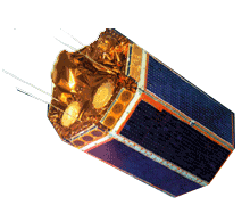Stretched Rohini Satellite Series
Stretched Rohini Satellite Series

The SROSS-C spacecraft. (Credit: ISRO)
The Stretched Rohini Satellite Series, or SROSS for short, were a series of satellites developed by the Indian Space Research Organization to carry small scientificy and technology payloads.
Lifetime: March 1987 (launch attempt of first SROSS satellite, SROSS 1/SROSS A) - July 2001 (orbital decay of last SROSS satellite, SROSS C2)
Country (primary): India
Primary Science
The SROSS satellites were designed to carry small science and technology payloads including astrophysics, remote sensing and upper atmopheric monitoring.
High Energy Science
Two of the SROSS satellites carried gamma-ray bursts experiments.
Links to more information
SROSS 3/SROSS C
Lifetime: May 1992 - July 1992
Primary Science
SROSS 3 carried two experimements: an experiment to detect gamma-ray bursts and a second to study Earth's upper atmosphere.
Science Highlights
- Detected 8 candidate gamma-ray bursts
Links to more information
SROSS C2
Lifetime: May 1994 - July 2001 (orbital decay)
Primary Science
The SROSS C2 payload was identical to that of SROSS 3. The two experiments were a gamma-ray burst detector and an instrument to study Earth's upper atmosphere.
Science Highlights
- Discovered a number of candidate gamma-ray bursts
- Contributed to gamma-ray burst positions as part of the Interplanetary Network

